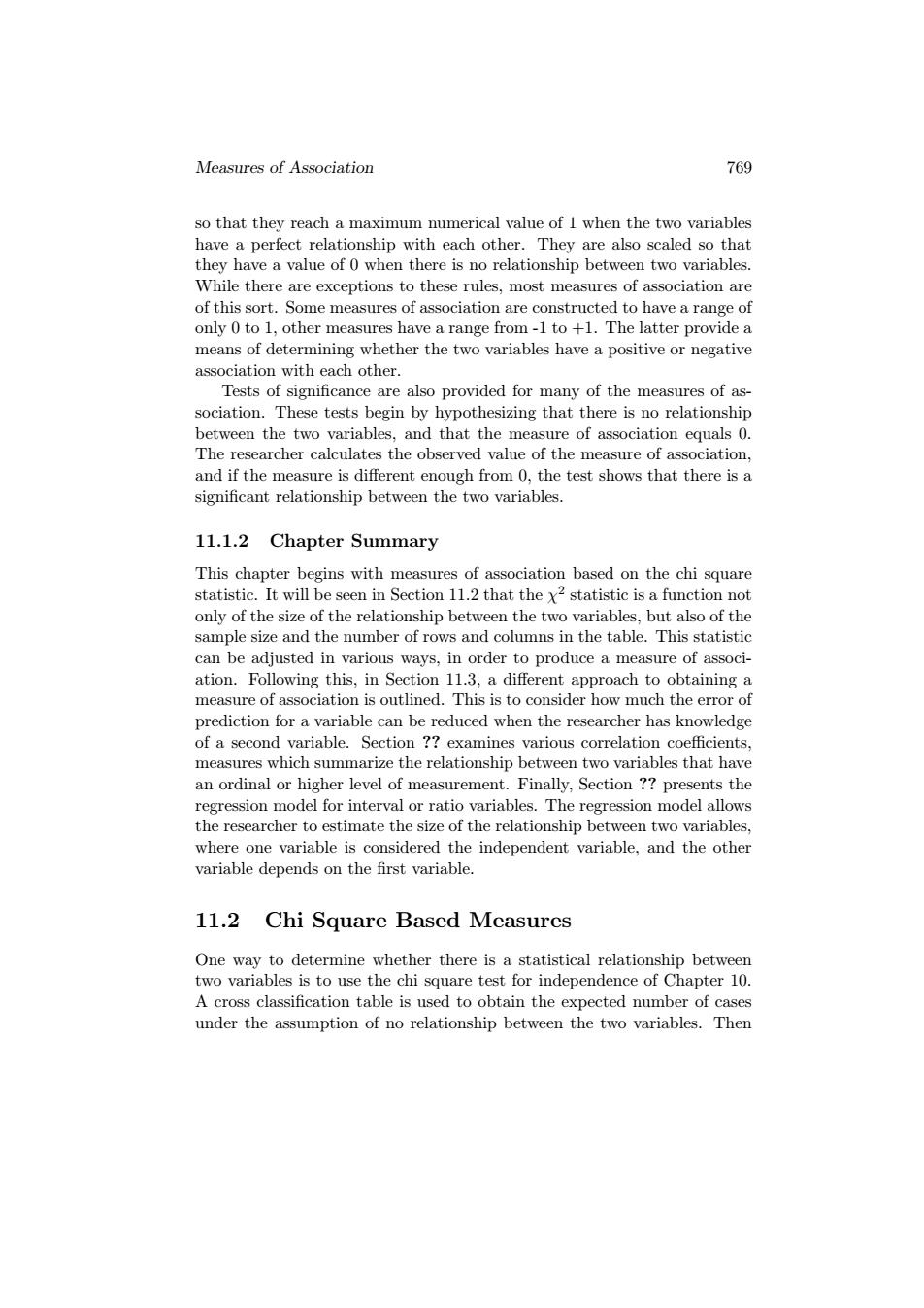正在加载图片...

Measures of Association 769 so that they reach a maximum numerical value of I when the two variables have a perfect relationship with each other.They are also scaled so that they have a value of 0 when there is no relationship between two variables. While there are exceptions to these rules,most measures of association are of this sort.Some measures of association are constructed to have a range of only 0 to 1,other measures have a range from-1 to +1.The latter provide a means of determining whether the two variables have a positive or negative association with each other. Tests of significance are also provided for many of the measures of as- sociation.These tests begin by hypothesizing that there is no relationship between the two variables,and that the measure of association equals 0. The researcher calculates the observed value of the measure of association, and if the measure is different enough from 0,the test shows that there is a significant relationship between the two variables. 11.1.2 Chapter Summary This chapter begins with measures of association based on the chi square statistic.It will be seen in Section 11.2 that the x2 statistic is a function not only of the size of the relationship between the two variables,but also of the sample size and the number of rows and columns in the table.This statistic can be adjusted in various ways,in order to produce a measure of associ- ation.Following this,in Section 11.3,a different approach to obtaining a measure of association is outlined.This is to consider how much the error of prediction for a variable can be reduced when the researcher has knowledge of a second variable.Section ?examines various correlation coefficients, measures which summarize the relationship between two variables that have an ordinal or higher level of measurement.Finally,Section ?presents the regression model for interval or ratio variables.The regression model allows the researcher to estimate the size of the relationship between two variables, where one variable is considered the independent variable,and the other variable depends on the first variable. 11.2 Chi Square Based Measures One way to determine whether there is a statistical relationship between two variables is to use the chi square test for independence of Chapter 10. A cross classification table is used to obtain the expected number of cases under the assumption of no relationship between the two variables.ThenMeasures of Association 769 so that they reach a maximum numerical value of 1 when the two variables have a perfect relationship with each other. They are also scaled so that they have a value of 0 when there is no relationship between two variables. While there are exceptions to these rules, most measures of association are of this sort. Some measures of association are constructed to have a range of only 0 to 1, other measures have a range from -1 to +1. The latter provide a means of determining whether the two variables have a positive or negative association with each other. Tests of significance are also provided for many of the measures of association. These tests begin by hypothesizing that there is no relationship between the two variables, and that the measure of association equals 0. The researcher calculates the observed value of the measure of association, and if the measure is different enough from 0, the test shows that there is a significant relationship between the two variables. 11.1.2 Chapter Summary This chapter begins with measures of association based on the chi square statistic. It will be seen in Section 11.2 that the χ 2 statistic is a function not only of the size of the relationship between the two variables, but also of the sample size and the number of rows and columns in the table. This statistic can be adjusted in various ways, in order to produce a measure of association. Following this, in Section 11.3, a different approach to obtaining a measure of association is outlined. This is to consider how much the error of prediction for a variable can be reduced when the researcher has knowledge of a second variable. Section ?? examines various correlation coefficients, measures which summarize the relationship between two variables that have an ordinal or higher level of measurement. Finally, Section ?? presents the regression model for interval or ratio variables. The regression model allows the researcher to estimate the size of the relationship between two variables, where one variable is considered the independent variable, and the other variable depends on the first variable. 11.2 Chi Square Based Measures One way to determine whether there is a statistical relationship between two variables is to use the chi square test for independence of Chapter 10. A cross classification table is used to obtain the expected number of cases under the assumption of no relationship between the two variables. Then